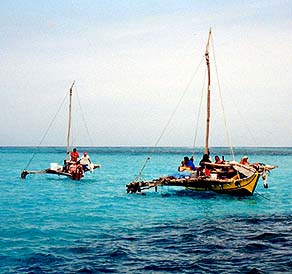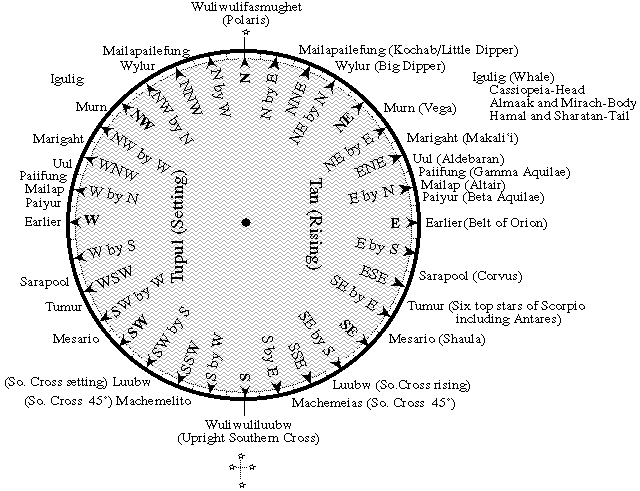|
Ku Holo Mau / Sail On, Sail Always, Sail Forever 2007 Voyage to Micronesia for Mau Piailug Navigation in the Western Pacific Photo right: Two Micronesian canoes (by Benigno Sablan, from "Replanting" at the Pacific Worlds website); photo left: a gathering of Pacific canoes at Rarotonga in 1992, inspired by Mau's teachings (by Moana Doi in "The Voyage to Ra'iatea and Rarotonga" at the PVS website).
To learn more about Navigation in the Western Pacific, see the following websites: Traditional Navigation in the Western Pacific, at the University of Pennsylvania Museum of Archaeology and Anthropology website; Navigation in Yap, told by Steven Tilwemal from Ifalik, at the Pacific Worlds website; and Reading the Wind, a PDF file of curriculum materials to "foster appreciation of the skills and achievements of Pacific Navigators" and to "explore the navigator's skill of forecasting weather and interpreting the environment to find direction," at the Pacific Resources for Education and Learning (PREL) website.
Gladwin, Thomas. East Is a Big Bird. Cambridge: Harvard University Press, 1970. Lewis, David. We, the Navigators: The Ancient Art of Landfinding in the Pacific. 2nd Edition. Honolulu: University of Hawaii Press, 1994. A Pacific-wide school of navigation is currently being planned to ensure that traditional navigation and Mau's dream of keeping cultural traditions alive, will survive for future generations. Mau has trained a new generation of navigators from Hawai’i, Aotearoa, the Marquesas, the Cook Islands, Tahiti Nui, and other Polynesian islands. Voyaging societies have been formed and canoes have been built in places where Mau has taught navigation. It is hoped that all who have learned from Mau will participate in this school. The name of the voyage "Ku Holo Mau / Sail On, Sail Always, Sail Forever," given to Na Kalai Wa'a Moku O Hawai'i by Pua Kanaka'ole for the building of Mau's canoe and its first voyage, emphasizes the perpetuation of Mau's voyaging and navigation tradition--today and for always. A Micronesian Star Compass, based on the teachings of Mau:
|

 Over 4,000 years ago, the islands of the western Pacific were settled by voyaging communities navigating without instruments across hundreds of miles of open ocean from the islands of Southeast Asia. Expert navigators read signs in the natural environment for directions and landfall. These signs included the rising and setting points of the sun, moon, and stars; winds and clouds; ocean swells; sea animals and sea birds that nested on islands; land plants and debris drifting in the ocean currents; and the shallow-water reflection of light on the undersides of clouds. Mau's navigation is a living legacy of this millienia-old tradition.
Over 4,000 years ago, the islands of the western Pacific were settled by voyaging communities navigating without instruments across hundreds of miles of open ocean from the islands of Southeast Asia. Expert navigators read signs in the natural environment for directions and landfall. These signs included the rising and setting points of the sun, moon, and stars; winds and clouds; ocean swells; sea animals and sea birds that nested on islands; land plants and debris drifting in the ocean currents; and the shallow-water reflection of light on the undersides of clouds. Mau's navigation is a living legacy of this millienia-old tradition. The following books also contain information about navigation in the Western Pacific:
The following books also contain information about navigation in the Western Pacific: